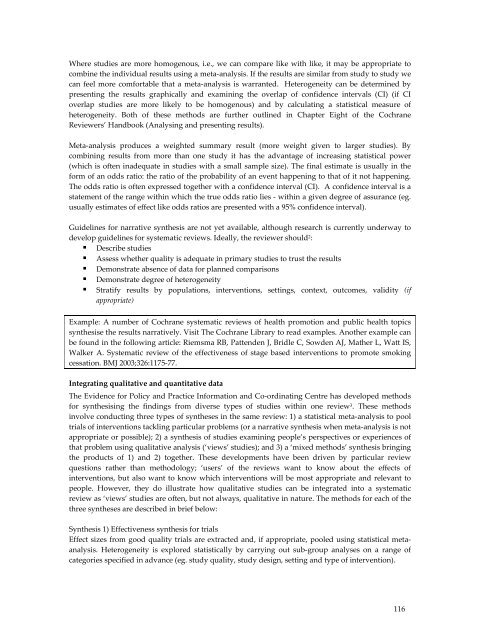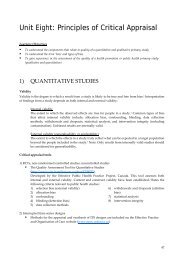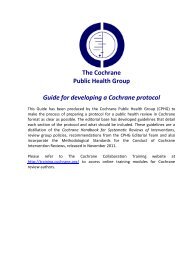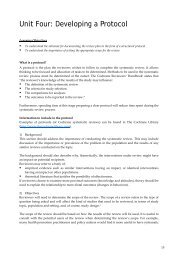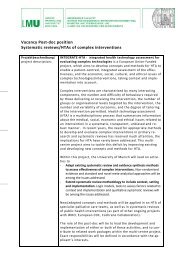Train the Trainer Course book - Cochrane Public Health Group
Train the Trainer Course book - Cochrane Public Health Group
Train the Trainer Course book - Cochrane Public Health Group
Create successful ePaper yourself
Turn your PDF publications into a flip-book with our unique Google optimized e-Paper software.
Where studies are more homogenous, i.e., we can compare like with like, it may be appropriate to<br />
combine <strong>the</strong> individual results using a meta-analysis. If <strong>the</strong> results are similar from study to study we<br />
can feel more comfortable that a meta-analysis is warranted. Heterogeneity can be determined by<br />
presenting <strong>the</strong> results graphically and examining <strong>the</strong> overlap of confidence intervals (CI) (if CI<br />
overlap studies are more likely to be homogenous) and by calculating a statistical measure of<br />
heterogeneity. Both of <strong>the</strong>se methods are fur<strong>the</strong>r outlined in Chapter Eight of <strong>the</strong> <strong>Cochrane</strong><br />
Reviewers’ Hand<strong>book</strong> (Analysing and presenting results).<br />
Meta-analysis produces a weighted summary result (more weight given to larger studies). By<br />
combining results from more than one study it has <strong>the</strong> advantage of increasing statistical power<br />
(which is often inadequate in studies with a small sample size). The final estimate is usually in <strong>the</strong><br />
form of an odds ratio: <strong>the</strong> ratio of <strong>the</strong> probability of an event happening to that of it not happening.<br />
The odds ratio is often expressed toge<strong>the</strong>r with a confidence interval (CI). A confidence interval is a<br />
statement of <strong>the</strong> range within which <strong>the</strong> true odds ratio lies - within a given degree of assurance (eg.<br />
usually estimates of effect like odds ratios are presented with a 95% confidence interval).<br />
Guidelines for narrative syn<strong>the</strong>sis are not yet available, although research is currently underway to<br />
develop guidelines for systematic reviews. Ideally, <strong>the</strong> reviewer should 2 :<br />
Describe studies<br />
Assess whe<strong>the</strong>r quality is adequate in primary studies to trust <strong>the</strong> results<br />
Demonstrate absence of data for planned comparisons<br />
Demonstrate degree of heterogeneity<br />
Stratify results by populations, interventions, settings, context, outcomes, validity (if<br />
appropriate)<br />
Example: A number of <strong>Cochrane</strong> systematic reviews of health promotion and public health topics<br />
syn<strong>the</strong>sise <strong>the</strong> results narratively. Visit The <strong>Cochrane</strong> Library to read examples. Ano<strong>the</strong>r example can<br />
be found in <strong>the</strong> following article: Riemsma RB, Pattenden J, Bridle C, Sowden AJ, Ma<strong>the</strong>r L, Watt IS,<br />
Walker A. Systematic review of <strong>the</strong> effectiveness of stage based interventions to promote smoking<br />
cessation. BMJ 2003;326:1175-77.<br />
Integrating qualitative and quantitative data<br />
The Evidence for Policy and Practice Information and Co-ordinating Centre has developed methods<br />
for syn<strong>the</strong>sising <strong>the</strong> findings from diverse types of studies within one review 3 . These methods<br />
involve conducting three types of syn<strong>the</strong>ses in <strong>the</strong> same review: 1) a statistical meta-analysis to pool<br />
trials of interventions tackling particular problems (or a narrative syn<strong>the</strong>sis when meta-analysis is not<br />
appropriate or possible); 2) a syn<strong>the</strong>sis of studies examining people’s perspectives or experiences of<br />
that problem using qualitative analysis (‘views’ studies); and 3) a ‘mixed methods’ syn<strong>the</strong>sis bringing<br />
<strong>the</strong> products of 1) and 2) toge<strong>the</strong>r. These developments have been driven by particular review<br />
questions ra<strong>the</strong>r than methodology; ‘users’ of <strong>the</strong> reviews want to know about <strong>the</strong> effects of<br />
interventions, but also want to know which interventions will be most appropriate and relevant to<br />
people. However, <strong>the</strong>y do illustrate how qualitative studies can be integrated into a systematic<br />
review as ‘views’ studies are often, but not always, qualitative in nature. The methods for each of <strong>the</strong><br />
three syn<strong>the</strong>ses are described in brief below:<br />
Syn<strong>the</strong>sis 1) Effectiveness syn<strong>the</strong>sis for trials<br />
Effect sizes from good quality trials are extracted and, if appropriate, pooled using statistical metaanalysis.<br />
Heterogeneity is explored statistically by carrying out sub-group analyses on a range of<br />
categories specified in advance (eg. study quality, study design, setting and type of intervention).<br />
116


